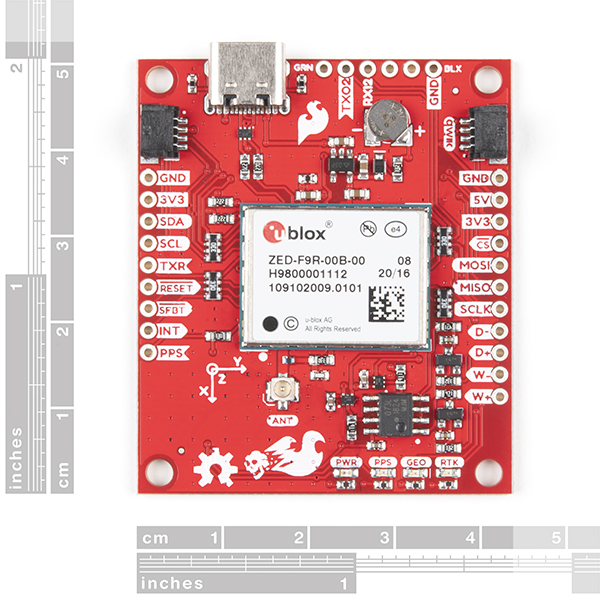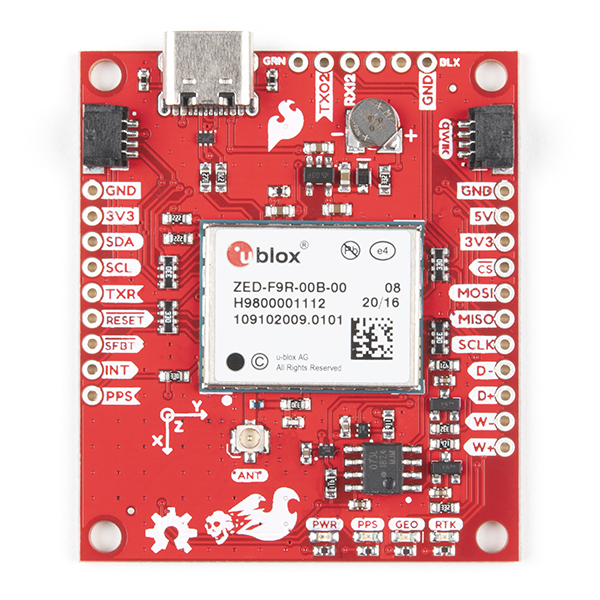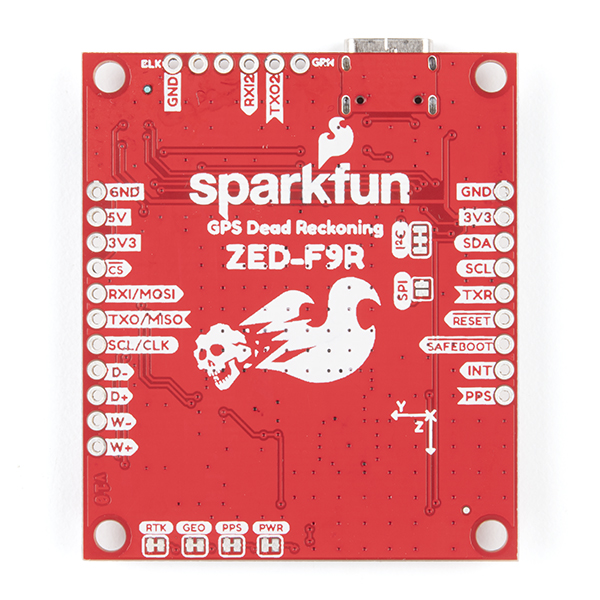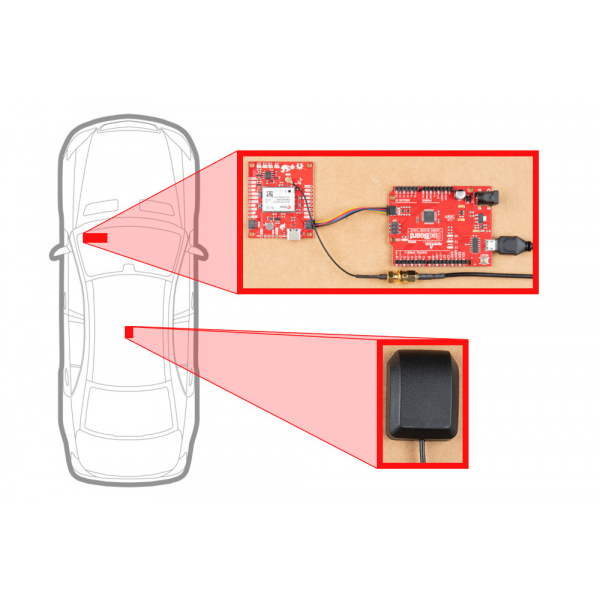SparkFun GPS-RTK Dead Reckoning Breakout - ZED-F9R (Qwiic)
The SparkFun ZED-F9R GPS Breakout is a high precision, sensor fusion GPS board with equally impressive configuration options and takes advantage of u-blox's Automotive Dead Reckoning (ADR) technology. The ZED-F9R module provides a highly accurate and continuous position by fusing a 3D IMU sensor, wheel ticks, a vehicle dynamics model, correction data, and GNSS measurements.
The ZED-F9R module is a 184-channel u-blox F9 engine GNSS receiver, meaning it can receive signals from the GPS, GLONASS, Galileo, and BeiDou constellations with ~0.2 meter accuracy! That's right, such accuracy can be achieved with an RTK navigation solution when used with a correction source. Note that the ZED-F9R can only operate as a rover, so you will need to connect to a base station. The module supports concurrent reception of four GNSS systems. The combination of GNSS and integrated 3D sensor measurements on the ZED-F9R provide accurate, real-time positioning rates of up to 30Hz.
Compared to other GPS modules, this breakout maximizes position accuracy in dense cities or covered areas. Even under poor signal conditions, continuous positioning is provided in urban environments and is also available during complete signal loss (e.g. short tunnels and parking garages). The ZED-F9R is the ultimate solution for autonomous robotic applications that require accurate positioning under challenging conditions.
Additionally, this u-blox receiver supports I2C (u-blox calls this Display Data Channel) which makes it perfect for the Qwiic compatibility so we don't have to use up our precious UART ports. Utilizing our handy Qwiic system, no soldering is required to connect it to the rest of your system. However, we still have broken out 0.1"-spaced pins in case you prefer to use a breadboard.
U-blox based GPS products are configurable using the popular, but dense, windows program called u-center. Plenty of different functions can be configured on the ZED-F9R: baud rates, update rates, geofencing, spoofing detection, external interrupts, SBAS/D-GPS, etc. All of this can be done within the SparkFun Arduino Library!
The SparkFun ZED-F9R GPS Breakout is also equipped with an on-board rechargeable battery that provides power to the RTC on the ZED-F9R. This reduces the time-to-first fix from a cold start (~26s) to a hot start (~2s). The battery will maintain RTC and GNSS orbit data without being connected to power for plenty of time.
This product requires an antenna: Be sure to check out the related products/hookup accessories and pick a suitble U.FL antenna for your project.
The SparkFun Qwiic Connect System is an ecosystem of I2C sensors, actuators, shields and cables that make prototyping faster and less prone to error. All Qwiic-enabled boards use a common 1mm pitch, 4-pin JST connector. This reduces the amount of required PCB space, and polarized connections mean you can’t hook it up wrong.
- 2x Qwiic Connectors
- Integrated U.FL connector for use with antenna of your choice
- Concurrent reception of GPS, GLONASS, Galileo and BeiDou
- 184-Channel GNSS Receiver
- Receives both L1C/A and L2C bands
- Horizontal Position Accuracy:
- 0.20m with RTK
- Max Navigation Rate: Up to 30Hz
- Time to First Fix
- Cold: 26s
- Hot: 2s
- Operational Limits
- Max G: ≤4G
- Max Altitude: 80km (49.7 miles)
- Max Velocity: 500m/s (1118mph)
- Velocity Accuracy: 0.5m/s
- Heading Accuracy: 0.2 degrees
- Built-In Accelerometer and Gyroscope
- Time Pulse Accuracy: 30ns
- Voltage: 5V or 3.3V but all logic is 3.3V
- Current: ~85mA to ~130mA (varies with constellations and tracking state)
- Software Configurable
- Geofencing
- Odometer
- Spoofing Detection
- External Interrupt
- Pin Control
- Low Power Mode
- Many others!
- Supports NMEA, UBX, and RTCM protocols over UART or I2C interfaces
SparkFun GPS-RTK Dead Reckoning Breakout - ZED-F9R (Qwiic) Product Help and Resources
What is GPS RTK?
September 14, 2018
Learn about the latest generation of GPS and GNSS receivers to get 14mm positional accuracy!
How to Build a DIY GNSS Reference Station
October 15, 2020
Learn how to affix a GNSS antenna, use PPP to get its ECEF coordinates and then broadcast your own RTCM data over the internet and cellular using NTRIP to increase rover reception to 10km!
SparkFun GPS-RTK Dead Reckoning ZED-F9R Hookup Guide
July 9, 2020
The u-blox ZED-F9R is a powerful GPS-RTK unit that uses a fusion of IMU, wheel ticks, a vehicle dynamics model, correction data, and GNSS measurements to provide highly accurate and continuous position for navigation in the difficult conditions. We will quickly get you set up using the Qwiic ecosystem through Arduino and Python so that you can start reading the output!
Setting up a Rover Base RTK System
October 14, 2020
Getting GNSS RTCM correction data from a base to a rover is easy with a serial telemetry radio! We'll show you how to get your high precision RTK GNSS system setup and running.
How to Upgrade Firmware of a u-blox GNSS Receiver
March 26, 2021
A few steps and you'll upgrade to the latest features on a u-blox GNSS receiver.
Core Skill: Programming
If a board needs code or communicates somehow, you're going to need to know how to program or interface with it. The programming skill is all about communication and code.
Skill Level: Experienced - You will require a firm understanding of programming, the programming toolchain, and may have to make decisions on programming software or language. You may need to decipher a proprietary or specialized communication protocol. A logic analyzer might be necessary.
See all skill levels
Core Skill: Electrical Prototyping
If it requires power, you need to know how much, what all the pins do, and how to hook it up. You may need to reference datasheets, schematics, and know the ins and outs of electronics.
Skill Level: Competent - You will be required to reference a datasheet or schematic to know how to use a component. Your knowledge of a datasheet will only require basic features like power requirements, pinouts, or communications type. Also, you may need a power supply that?s greater than 12V or more than 1A worth of current.
See all skill levels
Comments
Looking for answers to technical questions?
We welcome your comments and suggestions below. However, if you are looking for solutions to technical questions please see our Technical Assistance page.
Customer Reviews
No reviews yet.






Because the IMU / dead reckoning calibration requires going over 30 kmph and making multiple left and right turns after every cold start, this module is not suitable for general purpose rovers/robotics as advertised. This sensor seems to be designed specifically for cars, and the "Automotive" in "Automotive Dead Reckoning" is an important word for prospective customers to notice.
I bought one of these in 2020. I didn't really see a use case for it - combining high precision differential GNSS with low precision IMU - but since I had used u-blox modules with each of those individual capabilities (specifically ZED-F9P and NEO-M8U respectively) I thought it might be an interesting combination and maybe I was missing something. Recently while updating the ZED-F9R with the latest u-blox firmware, I noticed on the u-blox web site that this module has been discontinued by the manufacturer due to "low demand" - apparently no one else saw the use case either. Despite the (probably last) FW update, there is definitely a bug in the NMEA GSV sentences that the device emits (incorrect message indexing field). It was a fun idea, but in the spirit of sunk costs, time to start playing with something else. Reference: https://content.u-blox.com/sites/default/files/ZED-F9R-00B_EOL_UBX-21044624.pdf
I'm planning to use this board (ZED-F9R) for my robot rover as a ROVER. The BASE will be ZED-F9P. The RTK correction data shall come F9P via middle rage XBee. The rover getting the signals via XBee and forwarding to ZED-F9R. The ZED-F9R calculating the accurate location & the heading. The ZED-F9R passing the data to the rover's MCU.
My questions:
Where I have to connect the XBee's TX & RX pins on SparkFun GPS-RTK Dead Reckoning Breakout - ZED-F9R (Qwiic) board & SparkFun GPS-RTK2 Board - ZED-F9P (Qwiic) ? Just information to Your boards what I'm speaking about: https://www.sparkfun.com/products/16344 https://www.sparkfun.com/products/15136
Is it possible to send back the accurate location & heading data from the ROVER to the BASE, with the same XBees ? The ZED-F9P (BASE) is connected to a laptop.
From ZED-F9P (BASE), on which pins I can get the data in to the laptop's USB port?
Your valuable feedback highly appreciated.
Just got my hands on this. Had the similar ZED board without the dead reckoning, so thought it would be easy to upgrade. Yes and no: the pin out for connecting the bluetooth board is reversed on this one vs the prior board. Not impossible to solve but it makes me wonder why.
You prefer the old pinout better?
It is not a matter of preference for one vs the other. It is a matter of not liking a change that does not appear to have been necessary. Reversing the pinout creates one more way to fail. i.e when an owner of a prior gps-zed board tries to hook up the bluetooth card used with that board to this new upgraded board and assumes that since these are so similar, they would be laid out the same. bad on my part for making the assumption, bad on your part for making the change. it is a matter of having already soldered the connectors onto the new zed board before noticing this change, followed by confusion when the change is noticed and the resultant setup where the blue tooth board is now hanging out into space vs being on top of the ZED board. Consistency is the expectation. Calling out that change in the hook up guide would have been a nice touch.